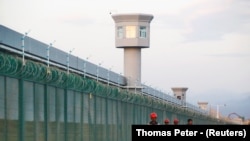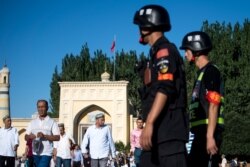During a November 16 news conference, Chinese Foreign Ministry Spokesperson Zhao Lijian was asked about comments made by Canada's Ambassador to the United Nations Bob Rae, who said there is no question that aspects of what China is doing to repress Uighurs in Xinjiang fit the legal definition of genocide.
Zhao dismissed this comparison with a claim of robust population growth in China’s northwestern Xinjiang region, home to the Uighur Muslim minority.
“The population of the Uighurs in Xinjiang rose from 10.17 million to 12.72 million, an increase of 2.55 million or 25%, which is about twice the increase of the whole Xinjiang population, which stood at 14%,” he said.
He further claimed that the growth rate of the Uighurs in Xinjiang was 12.5 times higher than that for the ethnic Han population, and 18 times higher than the population growth rate for Canada.
“I would like to ask this ambassador, if his logic is plausible in finding out who best fits the label of genocide, it seems that it is not the Uyghurs who are persecuted, but rather the people of Canada, am I right? You can see how ridiculous the ambassador's statement is,” Zhao said. “A piece of advice for him: Do some homework before crafting a publicity stunt, so as not to make a fool of himself.”
Zhao’s comments are misleading. There is significant evidence that China is pursuing a policy of “demographic genocide” against Uighurs.
“The 25% increase is some strange non-public figure,” Adrian Zenz, who is one of the world’s foremost scholars on the People’s Republic of China and has written extensively about the Uighur situation, told Polygraph.info.
“Actual Uighur population growth [for] 2010 to 2018 from statistical Xinjiang yearbooks was lower,” Zenz said. “The figure they cite has no publicly verifiable source.”
As Zenz previously noted in his widely cited paper, “Sterilizations, IUDs, and Mandatory Birth Control: The CCP’s Campaign to Suppress Uyghur Birthrates in Xinjiang,” Uighur regions are apparently concealing data related to population growth, “indicating [the issue’s] increasing sensitivity.”
The source of Zhao’s statistics notwithstanding, his choice of timeline is telling. Many of China’s allegedly repressive policies, including mass incarceration, forced sterilization and other acts that critics allege amount to cultural genocide, were initiated or ramped up in the wake of the May 2014 Ürümqi suicide attacks.
After those attacks, which left 43 dead and over 90 wounded in the capital of Xinjiang, Chinese President Xi Jinping vowed “absolutely no mercy” in his response to violent extremism in the country.
Drawing from official data, Zenz reported that natural population growth rates dropped across all Chinese minority regions in 2015 — the same year the Communist Party government began citing a link between population growth and “religious extremism.”
According to Zenz, in 2010, nine of the top 10 Chinese counties with the highest natural population growth rates were Uighur or Kyrgyz, with birth rates around five times the national average.
However, natural population growth in Xinjiang dropped by 84% in the two largest Uighur prefectures — Hotan and Kashgar — between 2015 and 2018. It further dropped in several minority regions in 2019.
In 2017, the growth rates in Hotan and Kashgar fell to the same level of the average in minority counties, despite having long exceeded them.
Zenz further wrote that in 2020, officials in Kizilsu Prefecture, a “region dominated by Uighurs and Kazakhs,” set an “unprecedented near-zero birth rate target” of 1.05 per thousand. By contrast, the natural growth rate was 19.66% in 2018 and 8.18% in 2019.
“I think they opted for 2010 to 2018 in order to capture maximum Uighur population increase versus Han, given that around 2010 and in the early 2010s, Uighur birth rates were very high,” Zenz told Polygraph.info.
Chinese Government officials have correlated these drops to strict family planning policies.
Zenz’s research found that pregnancy checks, forced intrauterine devices, sterilization and even abortions were being employed in a sweeping campaign to slash birth rates among Uighurs and other ethnic minorities.
Citing official Chinese government documents, he revealed a 2019 plan to sterilize 14%-34% of all Uighur women of child-bearing age in two Uighur counties that year. That project, targeting all of southern Xinjiang, continued into 2020 with increased funding.
Having too many children “is a major reason” people are sent to the country’s sprawling network of detention camps, where as many as 3 million people have been locked up, Zenz wrote.
A report this past February by Germany’s Deutsche Welle (DW) news service noted that men had been incarcerated far more often than women, with Xinjiang expert Darren Byler of the University of Colorado arguing that Beijing seeks to “diminish the Uighur population as a way of reducing the threat perception.”
According to DW, men aged 20-40 account for 60% of internees. “This has major implications for demographics and the birth rate,” Rian Thum, an expert on China’s Uighur policy at the University of Nottingham, told the news service. “If you take a portion — or even the entirety — of a village’s youth, you basically put a pause” on the community’s growth.
Zenz noted in his report that “these findings provide the strongest evidence yet that Beijing’s policies in Xinjiang meet one of the genocide criteria cited in the U.N. Convention on the Prevention and Punishment of the Crime of Genocide, namely that of Section D of Article II: ‘imposing measures intended to prevent births within the [targeted] group’.”
Joanne Smith Finley, a reader in Chinese studies at the United Kingdom’s Newcastle University, categorically condemned such practices, which experts have termed “demographic genocide.”
“It’s genocide, full stop,” she told the Associated Press in an investigation published in June. “It’s not immediate, shocking, mass-killing on the spot type genocide, but it’s slow, painful, creeping genocide.”
Other efforts are under way in Xinjiang to suppress the cultural identity of Uighur Muslims.
According to a January report from Radio Free Asia (RFA), authorities ordered Uighurs to “modernize” the interiors of their homes by swapping out ethnic decor with “Sinicized” furniture.
According to RFA, this campaign followed a “modernization” drive funded to the tune of U.S. $575 million, which entailed destroying elements of traditional Uighur design.
In May 2019, a joint investigation by U.K.’s Guardian newspaper and the investigative website Bellingcat found that more than two dozen mosques had been destroyed in Xinjiang over a two-year period.
Chinese authorities have also reportedly forced some Uighurs to drink alcohol and eat pork despite Islamic proscriptions.
It should be noted that cultural destruction does not amount to genocide under the U.N. Genocide Convention.
In the same CBC interview brought to Zhao’s attention, Ambassador Rae said that deeming China’s actions genocidal would require “a process of gathering information and of making sure that we've got the evidence that would support that kind of an allegation.”
In July, two Uighur groups, the East Turkistan Government in Exile and the East Turkistan National Awakening Movement, sought to do just that, submitting a complaint to the Office of the Prosecutor at the International Criminal Court alleging Chinese authorities had engaged in genocide and crimes against humanity.
Zenz told Polygraph.info there is strong evidence for making such a claim.
“The case for demographic genocide and the atrocity is of course based on dramatic [population] declines starting in 2017, draconian sterilization targets for 2019, plus punishing birth control violations with internment, a policy that started in 2018,” he said. “Also, a near-zero birth rate target for Kizilsu prefecture for 2020.”
In October, the U.S. joined 38 other U.N. member states in condemning China’s abuse of the Uighurs.
Later that month, the U.S. Congress issued a bipartisan resolution seeking to declare China’s actions against the Uighurs as genocide. In December 2019, an EU resolution also condemned the mass detention of Uighurs.
Tensions between Canada and China have also risen over other issues, including the arrest of Huawei’s chief financial officer, who is facing fraud charges in the U.S. over her alleged role in the company’s business dealings with Iran. That prompted the arrest of two Canadian citizens in China on espionage charges, and put a halt to free-trade discussions between the two countries.








